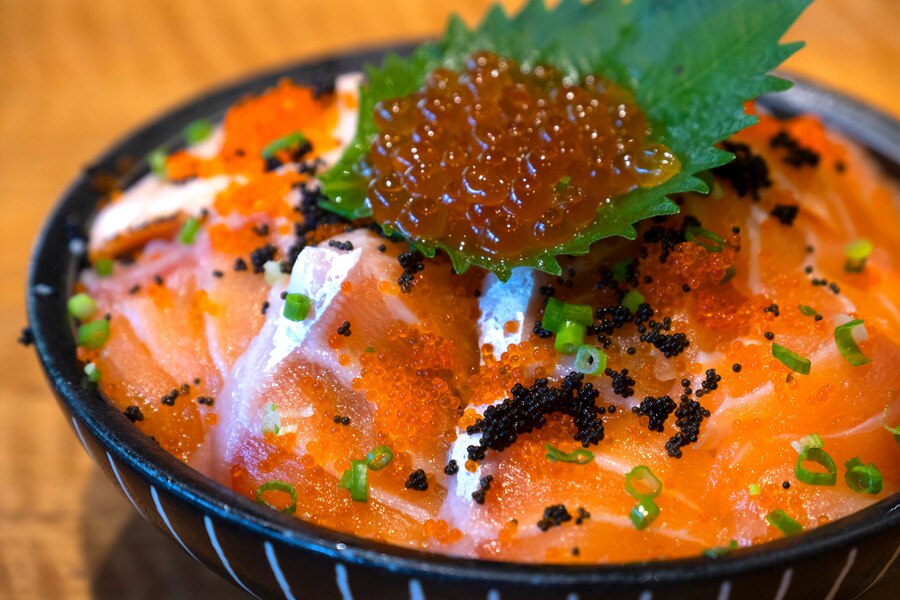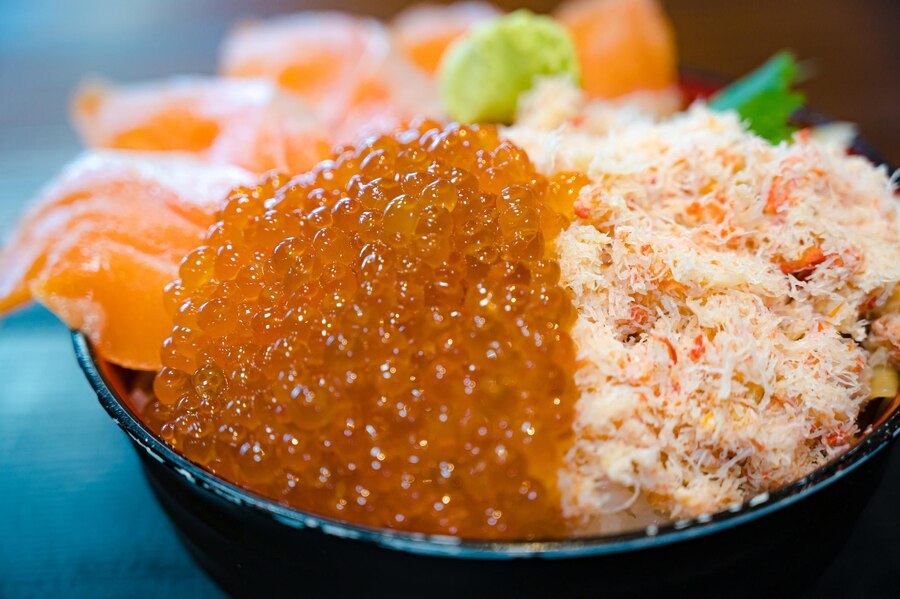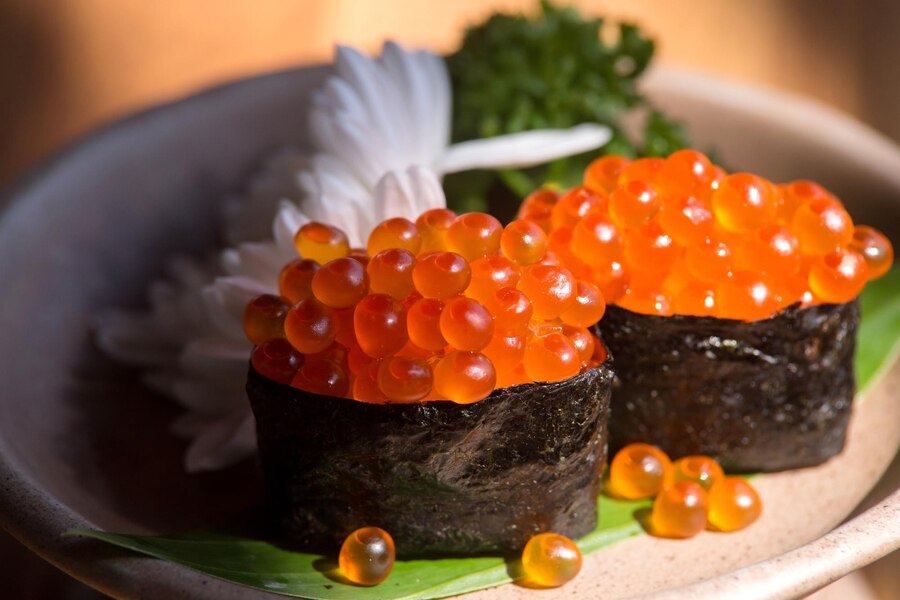
ikura, the Japanese word for salmon roe, is a culinary delight cherished by food enthusiasts worldwide. Known for its vibrant orange color and bursting flavor, ikura holds a special place in Japanese cuisine. Whether enjoyed atop sushi or incorporated into various dishes, ikura’s unique texture and taste make it a standout ingredient. This blog will take you on a delectable journey, exploring its historical significance, health benefits, and culinary versatility.
One of the most significant health benefits of ikura lies in its high Omega-3 fatty acid content. These essential fats play a crucial role in maintaining heart health, reducing inflammation, and supporting brain function. Regular consumption of Omega-3 fatty acids can lower the risk of chronic conditions like heart disease and arthritis.
Ikura is also a fantastic source of protein, an essential macronutrient for building and repairing tissues. Protein-rich diets promote muscle growth and aid in maintaining a healthy weight. Including ikura in your meals can provide a protein boost without the need for heavy, calorie-dense foods.
In addition to Omega-3s and protein, ikura is rich in vitamins and minerals that support overall health. It contains Vitamin A, which is vital for vision and immune function, and Vitamin D, which aids in calcium absorption and bone health. Additionally, ikura is a good source of selenium, a mineral that acts as an antioxidant and supports thyroid function.
In Japanese cuisine, ikura is often enjoyed as a topping for sushi and sashimi. The popping sensation of the roe adds a delightful texture to each bite. Ikura donburi, a rice bowl topped with generous amounts of salmon roe, is another traditional favorite. The contrasting flavors of the salty roe and the slightly sweet rice create a harmonious dish.
Modern chefs are experimenting with ikura in creative ways. From ikura-topped canapés to ikura-infused sauces, the roe’s versatility shines through. It pairs well with various ingredients, adding a burst of flavor and an aesthetic touch to any dish. Try incorporating ikura into your next dinner party menu to impress your guests with its unique taste and presentation.
Ikura has also found its way into non-Japanese dishes. In fusion cuisine, it is used to elevate classic recipes, such as ikura-topped pasta or ikura-avocado toast. The roe’s briny flavor complements a range of ingredients, making it a favorite among chefs aiming to blend culinary traditions.
To enjoy the best ikura, it’s essential to select fresh, high-quality roe. Look for ikura with a bright, glossy appearance and a firm texture. The eggs should be plump and resilient, indicating freshness. Avoid ikura that looks dull or has a mushy consistency, as these are signs of aging.
With the rising demand for ikura, sustainable sourcing has become crucial. Opt for suppliers who prioritize ethical fishing practices and sustainability. Sustainable ikura sourcing ensures that salmon populations remain healthy and that ecosystems are not disrupted by overfishing.
Proper storage is vital to preserving ikura’s quality. Keep the roe refrigerated and consume it within a few days of purchase. If you need to store it longer, freezing is an option, but be aware that the texture may change slightly upon thawing. Handle ikura gently to prevent the delicate eggs from bursting.
 North American Delights
North American DelightsIn North America, ikura has gained popularity as a luxurious topping for various dishes. From ikuras-topped bagels to gourmet omelets, the roe adds a touch of elegance and a burst of umami flavor. Its integration into brunch menus and upscale dining experiences showcases its versatility.
European chefs have embraced ikuras in innovative ways, incorporating it into dishes that highlight its unique qualities. Ikuras-topped blinis, a Russian-inspired appetizer, are a hit at sophisticated gatherings. The roe’s briny notes complement the creamy textures of European dishes, creating a harmonious balance.
Beyond Japan, other Asian cuisines have adopted ikuras to enhance their traditional recipes. In Korean cuisine, ikuras is sometimes added to bibimbap, a mixed rice dish, for an extra layer of flavor. Thai chefs have experimented with ikuras in seafood salads, blending the roe’s taste with vibrant herbs and spices.
The environmental impact of ikuras sourcing cannot be ignored. Overfishing and habitat destruction pose significant threats to salmon populations. Sustainable fishing practices, such as selective harvesting and habitat conservation, are essential to protect these valuable resources. Consumers can support sustainability by choosing ikuras from suppliers committed to environmentally friendly methods.
Ethical considerations in ikuras production extend beyond environmental concerns. It’s crucial to ensure that fishing practices respect the welfare of both the fish and the communities that depend on them. Supporting fair trade and responsible sourcing initiatives helps promote ethical treatment and fair compensation for workers involved in ikuras production.
As consumers, we have the power to make informed choices that align with our values. By selecting sustainably sourced and ethically produced ikuras, we contribute to the preservation of marine ecosystems and the well-being of fishing communities. Look for certifications and labels that indicate responsible sourcing when purchasing ikuras.
 What is the best way to enjoy ikura?
What is the best way to enjoy ikura?Ikuras is best enjoyed fresh, as a topping for sushi or sashimi. Its briny flavor also pairs well with rice bowls and canapés. Be adventurous and try incorporating it into your favorite dishes for a burst of umami.
Pregnant women should exercise caution when consuming raw fish and roe. It’s advisable to consult with a healthcare professional before including ikuras in your diet during pregnancy to ensure safety.
Yes, ikuras can be frozen to extend its shelf life. However, keep in mind that freezing may slightly alter the texture. For the best experience, consume ikuras fresh and store it properly in the refrigerator.
Ikuras, with its rich history, impressive health benefits, and versatile culinary uses, is a gem in the world of gastronomy. From traditional Japanese dishes to modern fusion creations, ikuras continues to captivate taste buds and elevate dining experiences. By choosing sustainably sourced and ethically produced ikuras, we can enjoy this delicacy while supporting environmental conservation and ethical practices.
It is a long established fact that a reader will be distracted by the readable content of a page when looking at its layout. The point of using Lorem Ipsum is that it has a more-or-less normal distribution
contact us : laynmade5@gmail.com